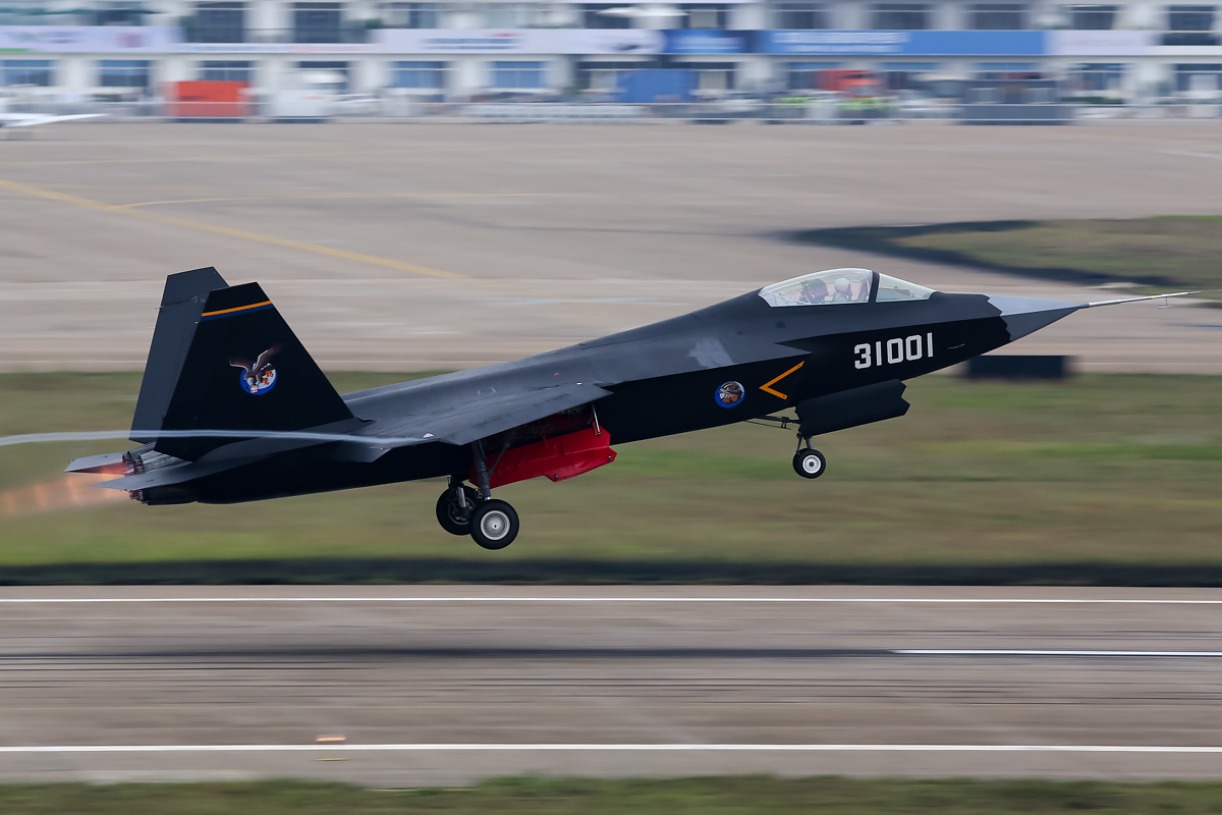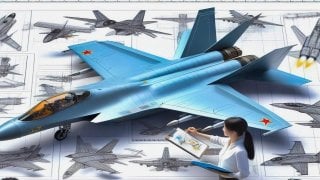J-35: China Is Working On a Stealth Fighter to Fly from Aircraft Carriers
China has a twinjet, fifth-generation prototype, the Shenyang FC-31 Gyrfalcon – which has an aircraft carrier capable variant known as the J-35.
Western powers are closely monitoring Chinese military developments. Understandable – given that China poses the most viable threat to US hegemony. Indeed, several factors lend to China’s potential: a stockpile of nuclear weapons; the world’s biggest population; the world’s second-biggest economy (with the latest potential to become the world’s biggest); a growing network, through the Belt & Road Initiative, of interconnected global economies; a revisionist agenda; a historic shipbuilding spree; and fifth-generation fighter technology.
China, with over 200 Chengdu J-20s, is one of just two nations who has fielded a fifth-generation fighter in any meaningful quantity (the other being the United States, who has fielded hundreds of both the F-22 and the F-35). While the J-20 is the hallmark of the Chinese fifth-generation fleet, China is actively working to diversify their fifth-generation portfolio. Notably, China has a twinjet, fifth-generation prototype, the Shenyang FC-31 Gyrfalcon – which has a carrier capable variant known as the J-35.
Here Comes the J-35 Fighter
When the People’s Liberation Army Air Force (PLAAF) endorsed Chengdu’s J-20 stealth fighter, Chengdu’s competitor, the Shenyang Aircraft Corporation proceeded with the development of their own fifth generation fighter – in the hope of securing an export customer.
In 2012, a one-quarter scale model of Shenyang’s FC-31 was revealed at the China International Aviation & Aerospace Exhibition. The model suggested that China was interested in exporting the FC-31 to customers who could not afford America’s F-35 Joint Strike Fighter.
A few years later, Shenyang attracted government funding, with the PLANAF and PLAAF apparently interested in the design. In June 2020, reports surfaced that a third variant of the FC-31 – with smoother lines, a bigger radome, and more closely aligned control surfaces (to reduce the jet’s radar signature) had been developed. The new variant was also aircraft carrier-capable, and was being referred to as the J-35.
J-35: A Real Threat to the U.S. Military?
The J-35 carrier-based variant of the FC-31 made its maiden flight on October 29, 2021.
The J-35 is expected to operate from the forthcoming Type 003 Fujian aircraft carrier, and will rely on China’s electromagnetic Aircraft Launch System (which should bear similarity to the American Ford-class’s EMALS launch system).

The J-35 also features a catapult launch bar and a wing-fold mechanism.
Not much is known about the J-35. And now, newly obtained footage has fueled speculation that the Chinese may be experimenting with an updated version of the J-35, or a new aircraft altogether.
“The rumors that this imagery shows a new or modified version of the aircraft are based primarily on a comparison of its wing with that of the naval J-35,” The War Zone reported. “The wing on the jet in the new imagery appears smaller, from some aspects at least, with the suggestion that the horizontal tail surfaces no longer ‘cut in’ to the wing in the same way.”
If the wing on the jet in the new images is smaller, “this could indeed indicate a land-based version. In the same way, the U.S. F-35C stealth fighter designed for carrier operations, features a notably larger wing than the land-based F-35A. Above all, this revised aerodynamic configuration serves to improve handling at low speeds, on approach to the carrier’s flight desk.”
All variants incorporate characteristics that reduce the aircraft’s radar cross-section, including forward-swept intake ramps with diverterless supersonic inlet (DSI) bumps, a two-piece bubble canopy, contoured weapon bays, and two oblique vertical stabilizers.
Some observers, like aviation journalist Bill Sweetman, for example, believe that the Shenyang jet is more closely modeled after the F-22 (on account of the similar platform, shape, aerodynamics, and airframe configuration) rather than the F-35.
The specifications
The FC-31/J-35 prototypes are reported to use the RD-93 engines. Although, China is understood to be working on an improved engine, the WS-13E, which is expected to offer 22,000 pounds of thrust. The WS-13 will possibly replace the RD-93 on the FC-31.
Currently, the FC-31 is believed to be able to handle a payload of 18,000 pounds. Internally, the FC-31 can handle four munitions weighing a total of 4,400 pounds. Externally, the FC-31 has six hardpoints, capable of carrying 13,000 pounds. The jet’s main armaments include the PL-10 short-range missile and the PL-12 medium-range air-to-air missile.
US officials believe that once the FC-31 enters service, the new jet will be well-equipped to handle existing fourth-generation fighters like the F-15, F-16, and F/A-18. The FC-31 may even be a match for the F-22 and F-35.
Still, observers suggest the outcome will depend upon a number of variables, including the talent of the individual pilots and the abilities of the radar and other sensors.
While the true abilities of the FC-31 are not yet clear – China has demonstrated that they will not remain complacent concerning the quality of their domestically-built fighter technology.
About the Author
Harrison Kass is a defense writer with over 1,000 articles published over the last several years. An attorney, pilot, guitarist, and minor pro hockey player, Harrison joined the US Air Force as a Pilot Trainee but was medically discharged. Harrison holds a BA from Lake Forest College, a JD from the University of Oregon, and an MA from New York University. Harrison listens to Dokken.
All images are Creative Commons.


